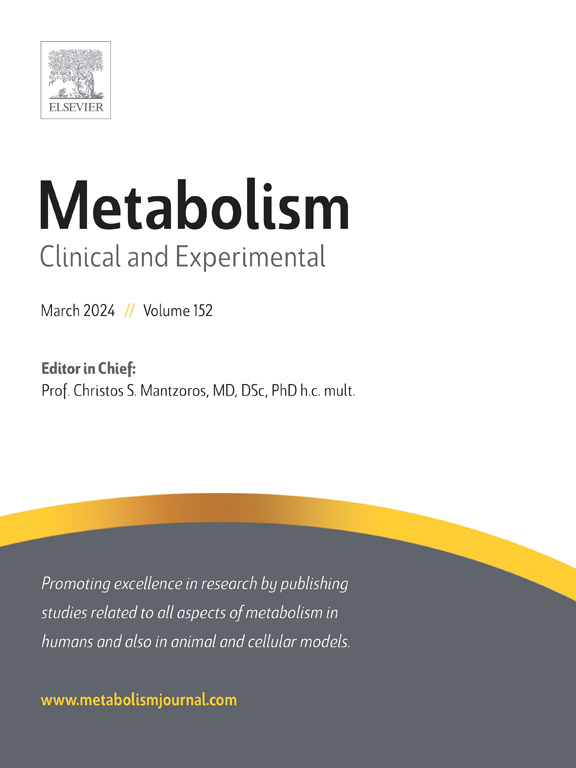Impact of metabolic dysfunction severity in steatotic liver disease and its interaction with liver fibrosis on all-cause mortality and multiple hepatic and extra-hepatic outcomes
IF 11.9
1区 医学
Q1 ENDOCRINOLOGY & METABOLISM
引用次数: 0
Abstract
Background
In metabolic dysfunction-associated steatotic liver disease (MASLD) and in MASLD with alcohol consumption (MetALD), we investigated the effect of severity of metabolic dysfunction on incident major adverse liver outcomes (MALO), major cardiovascular events (MACE), obesity-related cancers, and all-cause mortality (ACM).
Methods
SLD was identified among 502,381 UK Biobank participants using the Hepatic Steatosis Index (HSI) (>36 vs.<30). Metabolic syndrome (MetS) traits and MetS (≥3 traits) using MASLD/MetALD criteria. Cox regression was used to estimate adjusted hazard ratios and 95%CIs [aHR(95%CIs)] of MASLD or MetALD plus 1 to 5 MetS traits with incident MALO, MACE, obesity-related cancers and 5-year/10-year incidence rates versus reference (no SLD/MetS traits).
Results
Median follow-up was 148 to 149 months. Comparing MASLD with one versus five MetS traits, respectively, to the reference; for MALO, [aHRs (95%CIs)] were 2.27 (1.03–5.00) and 9.19 (4.98–16.95); for MetALD, aHRs were 1.65 (0.53–5.11) and 8.54 (3.65–19.95) respectively. For MACE, with MASLD; aHRs were 1.51 (1.19–1.92) and 4.81 (4.06–5.69) respectively; with MetALD, aHRs were 1.46 (1.00–2.13) and 4.64 (3.51–6.14) respectively. For obesity-related cancers; with MASLD, aHRs were 1.04 (0.87–1.23) and 1.46 (1.29–1.66) respectively; with MetALD, aHRs were 1.01 (0.79–1.29) and 1.51 (1.24–1.83) respectively. 5-year and 10-year incidence rates also increased progressively with increasing MetS traits. Combining SLD, MetS and high liver fibrosis risk (defined by FIB-4 ≥ 2.67) was strongly associated with MALO in both MASLD and MetALD (aHRs 27.48, (17.72–42.61); 43.36, 20.53–91.58 respectively).
Conclusion
In MASLD or MetALD, the numbers of MetS traits markedly influence risk and incidence of liver-related outcomes, MACE, obesity-related cancers and ACM.

脂肪变性肝病代谢功能障碍严重程度及其与肝纤维化的相互作用对全因死亡率和多肝及肝外预后的影响
背景:在代谢功能障碍相关的脂肪变性肝病(MASLD)和酒精摄入的MASLD (MetALD)中,我们研究了代谢功能障碍严重程度对主要不良肝脏结局(MALO)、主要心血管事件(MACE)、肥胖相关癌症和全因死亡率(ACM)的影响。方法:使用肝脂肪变性指数(HSI)在502,381名英国生物银行参与者中确定SLD (bbb36 vs.)。结果:中位随访时间为148至149 个月。将具有1个与5个MetS性状的MASLD分别与参考基因进行比较;MALO的ahr (95% ci)分别为2.27(1.03 ~ 5.00)和9.19 (4.98 ~ 16.95);MetALD的ahr分别为1.65(0.53 ~ 5.11)和8.54(3.65 ~ 19.95)。对于MACE,使用MASLD;ahr分别为1.51(1.19 ~ 1.92)和4.81 (4.06 ~ 5.69);与MetALD相比,ahr分别为1.46(1.00 ~ 2.13)和4.64(3.51 ~ 6.14)。与肥胖有关的癌症;MASLD的ahr分别为1.04(0.87-1.23)和1.46 (1.29-1.66);与MetALD相比,ahr分别为1.01(0.79 ~ 1.29)和1.51(1.24 ~ 1.83)。5年和10年的发病率也随着MetS特征的增加而逐渐增加。合并SLD、MetS和高肝纤维化风险(由FIB-4定义 ≥ 2.67)与MASLD和MetALD的MALO密切相关(aHRs 27.48, (17.72-42.61);43.36, 20.53-91.58)。结论:在MASLD或MetALD中,MetS特征的数量显著影响肝脏相关结局、MACE、肥胖相关癌症和ACM的风险和发生率。
本文章由计算机程序翻译,如有差异,请以英文原文为准。
求助全文
约1分钟内获得全文
求助全文
来源期刊

Metabolism: clinical and experimental
医学-内分泌学与代谢
CiteScore
18.90
自引率
3.10%
发文量
310
审稿时长
16 days
期刊介绍:
Metabolism upholds research excellence by disseminating high-quality original research, reviews, editorials, and commentaries covering all facets of human metabolism.
Consideration for publication in Metabolism extends to studies in humans, animal, and cellular models, with a particular emphasis on work demonstrating strong translational potential.
The journal addresses a range of topics, including:
- Energy Expenditure and Obesity
- Metabolic Syndrome, Prediabetes, and Diabetes
- Nutrition, Exercise, and the Environment
- Genetics and Genomics, Proteomics, and Metabolomics
- Carbohydrate, Lipid, and Protein Metabolism
- Endocrinology and Hypertension
- Mineral and Bone Metabolism
- Cardiovascular Diseases and Malignancies
- Inflammation in metabolism and immunometabolism
 求助内容:
求助内容: 应助结果提醒方式:
应助结果提醒方式:


